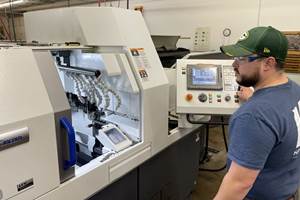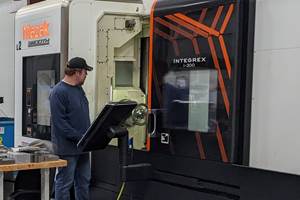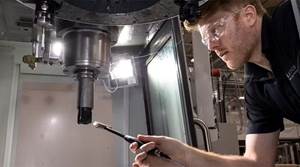Low-Cost Machines Meet High-End Controls
Mold and die makers have been less than enthusiastic about low-cost VMCs in a large part because their controls typically aren't designed to deliver the high performance 3D contouring capabilities so necessary to cutting cores and cavities. But two companies are out to change all that by bringing together low-cost machining capabilities and high-end contouring control on a single platform.
Share





Low-cost vertical machining centers have taken the market by storm in recent years because they deliver such extraordinary value. Mold and die makers have been comparatively less enthusiastic about low-cost VMCs, however, in a large part because their controls typically aren't designed to deliver the high performance 3D contouring capabilities so necessary to cutting cores and cavities. But two companies are out to change all that by bringing together low-cost machining capabilities and high-end contouring control on a single platform. That is, machine tool builder Haas Automation (Oxnard, California) and CNC builder Creative Technology Corp. (Arlington Heights, Illinois) have agreed to combine their expertise to produce low-cost VMCs aimed squarely at the die/mold market.
Haas Automation hardly needs an introduction anymore. Founded a little over a decade ago by Gene Haas to manufacture rotary indexers, the company has since risen to become America's largest unit volume producer of machine tools.
Creative Technology is also a young company, though it's founder, Todd Schuett, has been doing CNC development work for more than 20 years. Mr. Schuett introduced the PC-based Creative Evolution CNC in 1993, initially to serve retrofit applications. Creative's argument is that by updating the good old "iron" with state-of-the-art CNC technology, shops can get those machines to contour three to ten times faster than before and improve accuracy as well.
Big claims, for sure, but Creative has physics on their side. Newer CNC technology has the ability to dynamically "look ahead" in the part program for changes in cutter path direction and then automatically adjust the feed rate in order to execute that path as accurately as possible. Without look-ahead, the CNC can't "see" tight curves or sharp corners coming and thus will overshoot many path turns at higher feed rates due to machine inertia, or will undercut external corners due to servo lag. The machinist hoping to maintain a reasonably accurate 3D cutter path must therefore set the feed rate low enough to handle the most difficult workpiece features, and suffer through an excessively slow feed everywhere else.
With look-ahead, however, the feed rate can be set for the best-case cutting conditions. The CNC anticipates an approaching curve, slowing the feed to an appropriate rate, and then quickly accelerating back to a fast rate when the path ahead straightens out again. It is this ability to run faster throughout the entire part program that can have a huge positive impact on real machining rates, even in comparison to many systems that boast of very high rapid feed rates. As Mr. Schuett puts it, in 3D applications, "top speed is not as important as sustained speed. A sustained speed of, say, 120 ipm will yield better results in less time than brief bursts of speed at 400 ipm."
The CNC is very fast overall with high block processing and servo cycle times. It also features a large memory and the ability to direct network at a much higher transfer rate than can be achieved through serial port connections. These factors enable the CNC to execute the huge, point-dense tool path programs common in mold and die machining.
According to Creative, contrary to the impressions some people may have of low cost machine tools, the Haas machines lend themselves well to the higher mechanical performance requirements the CNC enables. Says operations VP Walter Berman, "The drives, motors and mechanics are more than needed. The machine is very accurate and extremely responsive. The end result to the user is that it is possible to purchase an inexpensive machine, combine it with a high performance control, and use it for high speed machining applications."
That's not to say that the Haas machine comes at the standard price with a Creative CNC. Indeed, the high performance control option may cost half again as much as the standard machine. Still, users now can get a surprisingly capable 3D machining system for less than $100,000. If you've done any shopping recently, you'll know that that's a whole lot less than you'd otherwise have to pay.
Related Content
ERP Provides Smooth Pathway to Data Security
With the CMMC data security standards looming, machine shops serving the defense industry can turn to ERP to keep business moving.
Read More5 Tips for Running a Profitable Aerospace Shop
Aerospace machining is a demanding and competitive sector of manufacturing, but this shop demonstrates five ways to find aerospace success.
Read MoreHow this Job Shop Grew Capacity Without Expanding Footprint
This shop relies on digital solutions to grow their manufacturing business. With this approach, W.A. Pfeiffer has achieved seamless end-to-end connectivity, shorter lead times and increased throughput.
Read MoreHow to Mitigate Chatter to Boost Machining Rates
There are usually better solutions to chatter than just reducing the feed rate. Through vibration analysis, the chatter problem can be solved, enabling much higher metal removal rates, better quality and longer tool life.
Read MoreRead Next
Machine Shop MBA
Making Chips and 91ÊÓƵÍøÕ¾ÎÛ are teaming up for a new podcast series called Machine Shop MBA—designed to help manufacturers measure their success against the industry’s best. Through the lens of the Top Shops benchmarking program, the series explores the KPIs that set high-performing shops apart, from machine utilization and first-pass yield to employee engagement and revenue per employee.
Read MoreAMRs Are Moving Into Manufacturing: 4 Considerations for Implementation
AMRs can provide a flexible, easy-to-use automation platform so long as manufacturers choose a suitable task and prepare their facilities.
Read More





















